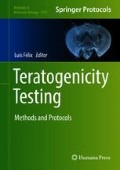Abstract
Environmental toxicants, chemical substances produced or introduced into the environment directly by humans or their activities, can act as teratogens during development that negatively impact health. Long-term ramifications of environmental exposures to sublethal doses of teratogens are often unrecognized and unknown. The round worm, Caenorhabditis elegans, is an emerging model organism to investigate the long-term impacts of environmental teratogens upon health. This chapter describes a toxicant exposure paradigm integrated with phenotyping assays to screen adult worms, and their progeny, for effects on reproduction, growth and development, behavior, and energy balance.
Access this chapter
Tax calculation will be finalised at checkout
Purchases are for personal use only
References
Wilson JG (1973) Environment and birth defects. Environmental science series. Academic Press, New York
Reed CE, Fenton SE (2013) Exposure to diethylstilbestrol during sensitive life stages: a legacy of heritable health effects. Birth Defects Res C Embryo Today 99(2):134–146. https://doi.org/10.1002/bdrc.21035
Sanders AP, Desrosiers TA, Warren JL et al (2014) Association between arsenic, cadmium, manganese, and lead levels in private wells and birth defects prevalence in North Carolina: a semi-ecologic study. BMC Public Health 14:955. https://doi.org/10.1186/1471-2458-14-955
Wigle DT, Arbuckle TE, Turner MC et al (2008) Epidemiologic evidence of relationships between reproductive and child health outcomes and environmental chemical contaminants. J Toxicol Environ Health B Crit Rev 11(5–6):373–517. https://doi.org/10.1080/10937400801921320
Grun F, Blumberg B (2006) Environmental obesogens: organotins and endocrine disruption via nuclear receptor signaling. Endocrinology 147(6 Suppl):S50–S55. https://doi.org/10.1210/en.2005-1129
Holtcamp W (2012) Obesogens: an environmental link to obesity. Environ Health Perspect 120(2):a62–a68. https://doi.org/10.1289/ehp.120-a62
Allard P, Colaiacovo MP (2010) Bisphenol A impairs the double-strand break repair machinery in the germline and causes chromosome abnormalities. Proc Natl Acad Sci U S A 107(47):20405–20410. https://doi.org/10.1073/pnas.1010386107
Parodi DA, Sjarif J, Chen Y, Allard P (2015) Reproductive toxicity and meiotic dysfunction following exposure to the pesticides Maneb, Diazinon and Fenarimol. Toxicol Res 4(3):645–654. https://doi.org/10.1039/C4TX00141A
Killeen A, Marín de Evsikova C (2016) Effects of sub-lethal teratogen exposure during larval development on egg laying and egg quality in adult Caenorhabditis elegans. F1000Res 5:2925. https://doi.org/10.12688/f1000research.8934.1
Marín de Evsikova C, Pivars B, Killeen AA et al (2017) Are you what your mother ate: Using C. elegans to detect developmental windows sensitive to environmental exposures on growth, fertility, and obesity. In: Society for developmental biology 76th annual meeting, Minneapolis, MN, 2017. Society for Developmental Biology
Hubbard EJA, Greenstein D (2005) Introduction to the germ line. In: WormBook. WormBook. https://doi.org/10.1895/wormbook.1.101.1
Brenner S (1974) The genetics of Caenorhabditis elegans. Genetics 77(1):71–94
Riddle DL, Blumenthal T, Meyer BJ, Priess JR (1997) C. elegans II. Cold Spring Harbor Laboratory Press, Cold Spring Harbor (NY)
Leung MC, Williams PL, Benedetto A et al (2008) Caenorhabditis elegans: an emerging model in biomedical and environmental toxicology. Toxicol Sci 106(1):5–28. https://doi.org/10.1093/toxsci/kfn121
Mimoto A, Fujii M, Usami M et al (2007) Identification of an estrogenic hormone receptor in Caenorhabditis elegans. Biochem Biophys Res Commun 364(4):883–888. https://doi.org/10.1016/j.bbrc.2007.10.089
Stiernagle T (2006) Maintenance of C. elegans. In: WormBook. WormBook. https://doi.org/10.1895/wormbook.1.101.1
Updike D, Strome S (2010) P granule assembly and function in Caenorhabditis elegans germ cells. J Androl 31(1):53–60. https://doi.org/10.2164/jandrol.109.008292
Byerly L, Cassada RC, Russell RL (1976) The life cycle of the nematode Caenorhabditis elegans: I. Wild-type growth and reproduction. Dev Bio 51(1):23–33. https://doi.org/10.1016/0012-1606(76)90119-6
Byerly L, Scherer S, Russell RL (1976) The life cycle of the nematode Caenorhabditis elegans: II. A simplified method for mutant characterization. Dev Bio 51(1):34–48. https://doi.org/10.1016/0012-1606(76)90120-2
Yen K, Le TT, Bansal A et al (2010) A comparative study of fat storage quantitation in nematode Caenorhabditis elegans using label and label-free methods. PLoS One 5(9):e12810. https://doi.org/10.1371/journal.pone.0012810
Avery L, Shtonda BB (2003) Food transport in the C. elegans pharynx. J Exp Biol 206(Pt 14):2441–2457
Nawa M, Kage-Nakadai E, Aiso S et al (2012) Reduced expression of BTBD10, an Akt activator, leads to motor neuron death. Cell Death Differ 19(8):1398–1407. https://doi.org/10.1038/cdd.2012.19
Miller KG, Alfonso A, Nguyen M et al (1996) A genetic selection for Caenorhabditis elegans synaptic transmission mutants. Proc Natl Acad Sci U S A 93(22):12593–12598
Hirsh D, Oppenheim D, Klass M (1976) Development of the reproductive system of Caenorhabditis elegans. Dev Bio 49(1):200–219. https://doi.org/10.1016/0012-1606(76)90267-0
Gulseven Sidir Y, Sidir I, Tasal E, Ermis E (2011) Studies on the electronic absorption spectra of some monoazo derivatives. Spectrochim Acta A Mol Biomol Spectrosc 78(2):640–647. https://doi.org/10.1016/j.saa.2010.11.040
Sidir I, Gulseven Sidir Y (2015) Estimation of ground and excited state dipole moments of oil red O by solvatochromic shift methods. Spectrochim Acta A Mol Biomol Spectrosc 135:560–567. https://doi.org/10.1016/j.saa.2014.07.049
Sıdır İ, Gülseven Sıdır Y, Berber H, Taşal E (2013) A study on solvatochromism of some monoazo dye derivatives. J Mol Liq 178((Supplement C)):127–136. https://doi.org/10.1016/j.molliq.2012.11.011
Sıdır YG, Sıdır İ, Berber H, Taşal E (2011) UV-spectral changes for some azo compounds in the presence of different solvents. J Mol Liq 162(3):148–154. https://doi.org/10.1016/j.molliq.2011.07.002
Ramirez-Zacarias JL, Castro-Munozledo F, Kuri-Harcuch W (1992) Quantitation of adipose conversion and triglycerides by staining intracytoplasmic lipids with oil red O. Histochemistry 97(6):493–497
Author information
Authors and Affiliations
Corresponding author
Editor information
Editors and Affiliations
Rights and permissions
Copyright information
© 2018 Springer Science+Business Media, LLC, part of Springer Nature
About this protocol
Cite this protocol
Marín de Evsikova, C. (2018). Insights into the Phenotypic and Behavioral Effects of Teratogenic Drugs in Caenorhabditis elegans . In: Félix, L. (eds) Teratogenicity Testing. Methods in Molecular Biology, vol 1797. Humana Press, New York, NY. https://doi.org/10.1007/978-1-4939-7883-0_11
Download citation
DOI: https://doi.org/10.1007/978-1-4939-7883-0_11
Published:
Publisher Name: Humana Press, New York, NY
Print ISBN: 978-1-4939-7882-3
Online ISBN: 978-1-4939-7883-0
eBook Packages: Springer Protocols

